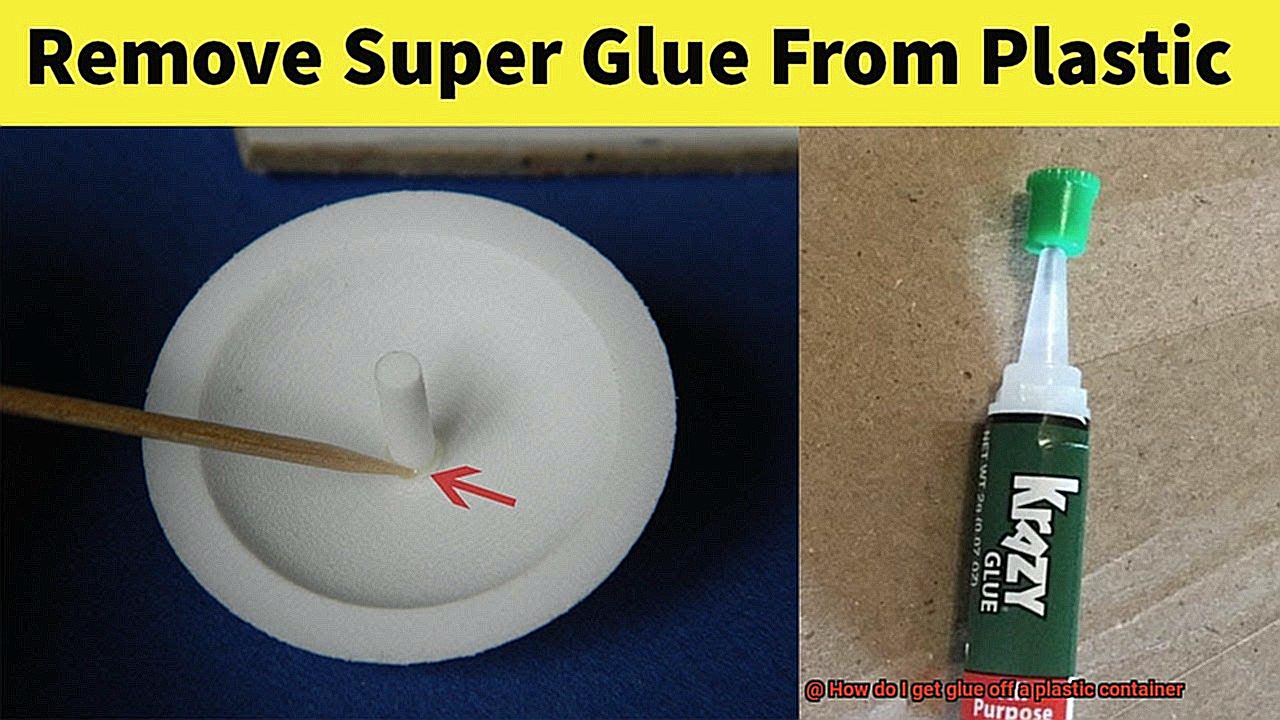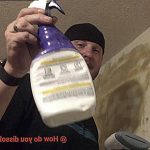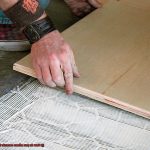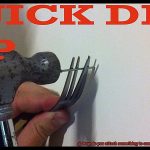Ever found yourself trapped in a gooey mess, desperately trying to liberate your plastic containers from the clutches of stubborn glue? We’ve all been there. Whether it’s a pesky price tag, an ambitious DIY project, or an accidental adhesive incident, removing glue from plastic containers can feel like an insurmountable challenge. But fear not, my fellow adhesive warriors, for we hold the key to conquering this relentless foe.
In this captivating guide, we will unveil an arsenal of battle-tested techniques that will help you bid farewell to sticky situations. We understand the frustration of grappling with glue residues that defy simple scrubbing. But fret no more, as solutions abound.
First up, let’s venture into the realm of natural remedies where everyday household items join forces against the tenacity of glue. Vinegar, baking soda, and even cooking oil will become your trusty comrades on this quest for cleanliness. Prepare to unlock their enchanting powers and follow our step-by-step instructions to unleash their full potential.
But wait. That’s not all. For those seeking a more industrial approach, we’ll also delve into specialized products tailored specifically for banishing stubborn adhesives. Armed with solvents and adhesive removers, your plastic containers will be restored to their former glory – free from any lingering traces of glue.
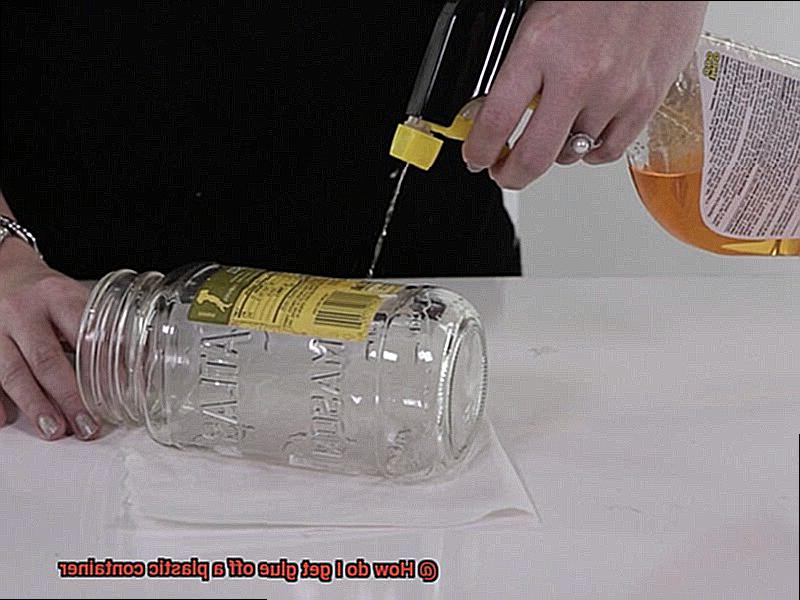
Are you ready to unravel the secrets behind liberating your plastic containers? Join us on this transformative journey where sticky residues become a thing of the past. Get ready to bid adieu to those bothersome remnants and rediscover the true shine of your plastic containers.
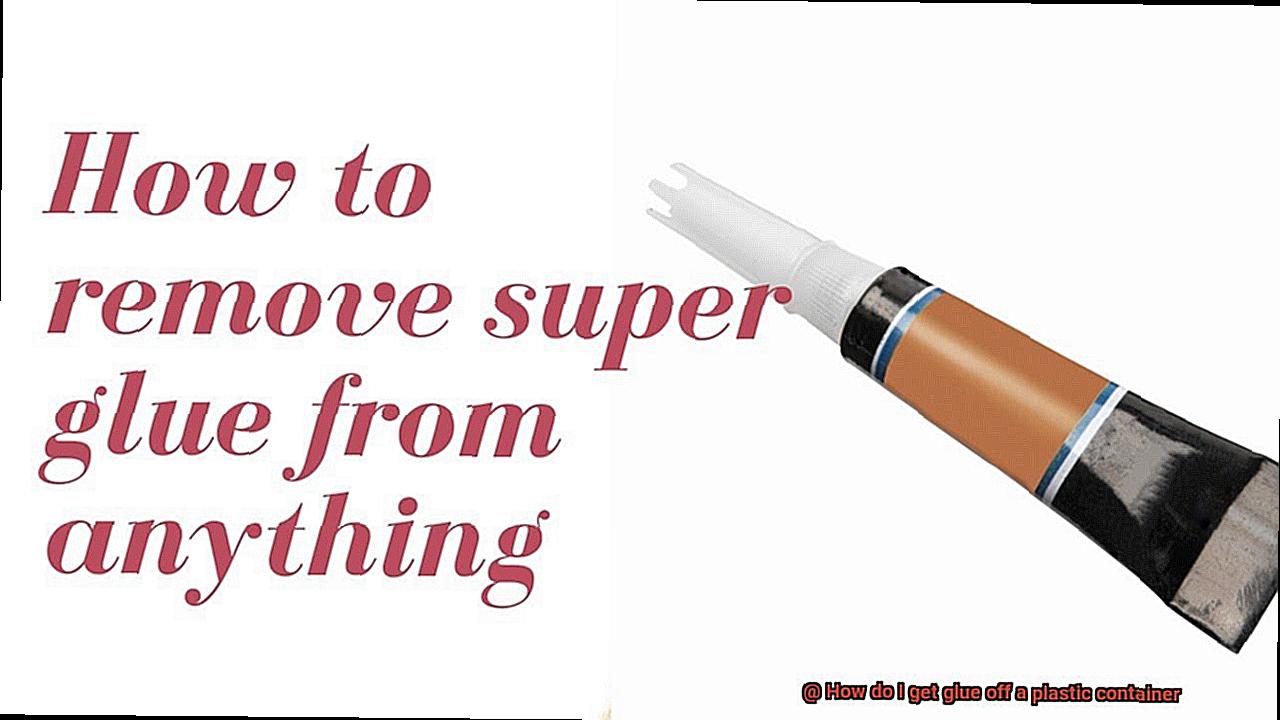
Types of Glue
Contents
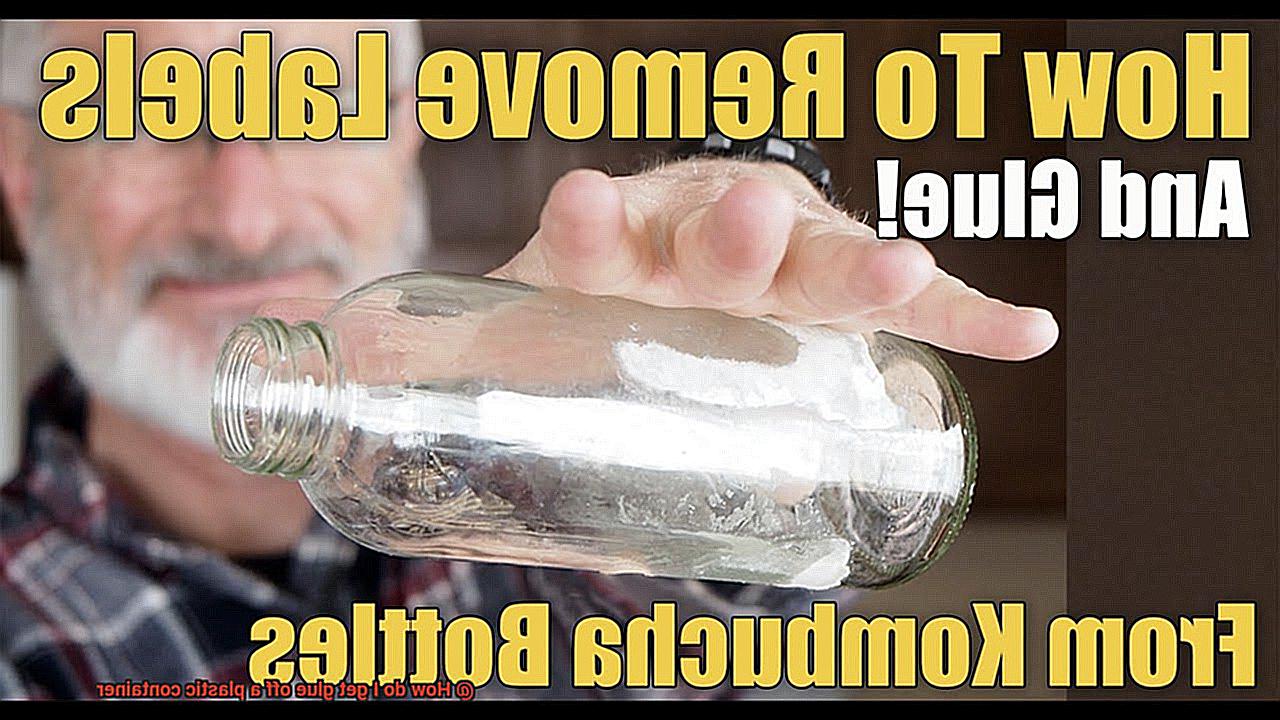
Prepare to embark on a journey through the fascinating realm of glue, where adhesive wonders await. In this article, we will delve into the diverse types of glue commonly used on plastic containers and uncover the secrets to removing them. Brace yourself for a thrilling exploration that will make you a glue aficionado.
Super Glue: The Swift and Strong Adhesive
Imagine a glue that dries in a flash and forms an unyielding bond. That’s super glue for you. Accidentally got some on a plastic container? Fear not. Acetone or nail polish remover comes to the rescue, breaking down the super glue and loosening its grip on the plastic surface.
Epoxy Glue: A Mighty Bond with Heat as its Nemesis
Epoxy glue commands respect with its formidable bonding powers. When it comes to removing epoxy glue from a plastic container, heat becomes your ally. Harness the power of a hairdryer or heat gun to gently warm the glue, rendering it more pliable and ready to be scraped off with a plastic scraper or credit card.
Craft Glue: A Delightfully Temporary Bond
Craft glues, such as white glue or PVA glue, grace our creative endeavors involving plastic containers. Luckily, craft glue is a temporary companion that bids farewell with ease. Once it has dried, simply peel it off or soak the affected area in warm soapy water for added assistance in loosening its grip.
Hot Glue: A Fiery Adhesive Adventure
Hold on tight as we explore the domain of hot glue, an adhesive that boldly bonds various materials, including plastics. Removing hot glue from a plastic container may seem like a daunting task due to its resistance to high temperatures. But fear not. Apply heat from a hairdryer or heat gun, watching as the glue softens, making it a breeze to peel off or scrape away.
Silicone Adhesive: The Flexible Waterproof Warrior
Silicone adhesive, a versatile glue known for its flexibility and waterproof properties, is commonly used for sealing and bonding plastic containers. Removing silicone adhesive may require a touch more finesse. Employ a silicone sealant remover or gently scrape the adhesive with a plastic scraper, taking care not to damage the plastic surface.
Types of Plastic Containers
Removing glue from plastic containers can be a challenging task, but with a little knowledge about the different types of plastics and their compatibility with glue removers, you’ll be able to conquer any sticky situation. In this article, we will dive deep into the world of plastic containers, exploring their characteristics, uses, and how they interact with various glue removal methods. Armed with this information, you’ll be able to safely and effectively remove glue from any plastic container.
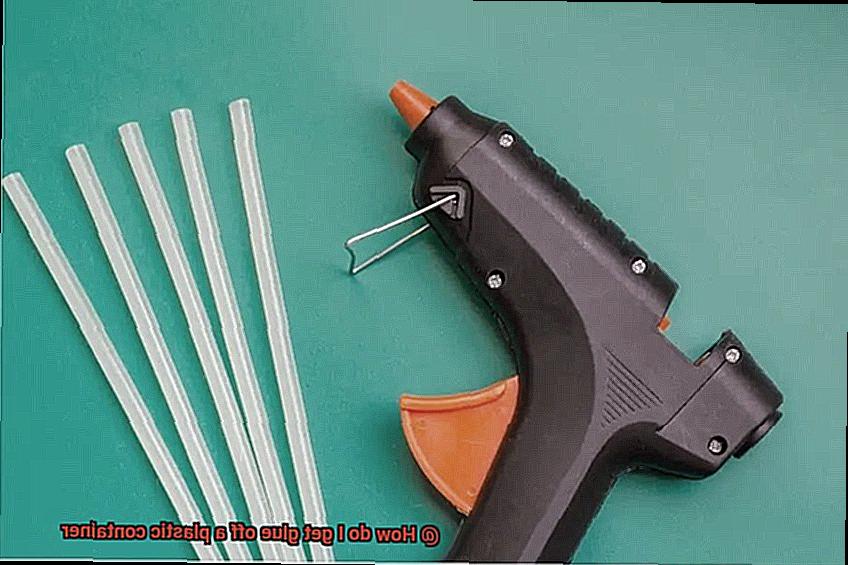
Unveiling Plastic Container Types:
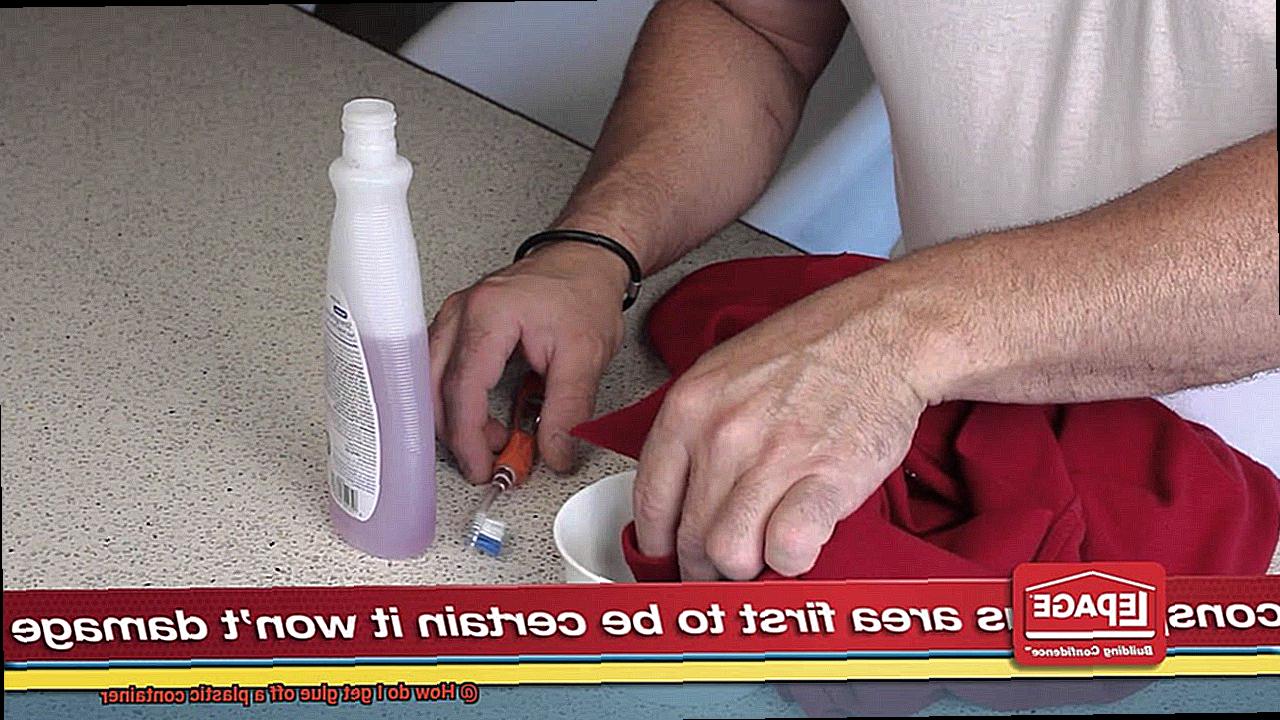
Plastic containers come in various shapes, sizes, and materials. It’s important to understand the different types of plastics commonly used in household and industrial settings. Some widely used plastics include PET (polyethylene terephthalate), HDPE (high-density polyethylene), PVC (polyvinyl chloride), LDPE (low-density polyethylene), and PP (polypropylene). These plastics have distinct properties and purposes that make them suitable for specific applications.
For instance, PET is transparent and lightweight, making it ideal for water bottles and food packaging. HDPE is known for its durability and resistance to chemicals, making it a popular choice for milk jugs and detergent bottles. PVC offers strength and chemical resistance, making it suitable for pipes and vinyl flooring. LDPE’s flexibility makes it perfect for squeeze bottles and plastic bags. PP provides excellent heat resistance and is commonly found in food containers and medicine bottles.
Determining Compatibility with Glue Removers:
The type of plastic container you have plays a crucial role in determining the compatibility with different glue removers. Not all plastics react the same way to solvents or cleaning agents, which is why it’s essential to match the right glue removal method to the specific type of plastic.
For example, using heat to soften the glue might work well on some plastics but could lead to warping or melting on others. Researching the specific type of plastic container you have will help you choose the most suitable glue removal method.
Tailoring Glue Removal Methods for Each Plastic Type:
To successfully remove glue from plastic containers without causing damage, it’s important to select the appropriate removal method for each plastic type. For more delicate plastics like PET or HDPE, using a commercial adhesive remover or a solvent specifically designed for plastic surfaces is a safe and effective option. Apply the remover directly to the glue, allow it to sit for a few minutes, and then gently wipe away the softened adhesive.
For tougher glues or stubborn residues, DIY solutions like rubbing alcohol or acetone can be employed. However, it’s crucial to conduct a small patch test before applying these solvents to avoid any unwanted damage or discoloration.
Using Heat to Remove Glue
Today, we’re delving into the fascinating world of using heat to remove glue from plastic containers. It’s a tried-and-true method, known for its effectiveness in softening adhesive and making removal a breeze. So grab your trusty hairdryer or heat gun, because we’re about to get heated.
First things first, set your hairdryer or heat gun to a low or medium heat setting. We don’t want to cause any damage to the precious plastic container, so let’s keep it gentle. Position the appliance about 6 inches away from the glue and start moving it back and forth in a sweeping motion. This rhythmic dance will evenly distribute the heat, gradually softening the adhesive.
Now, let the magic unfold before your eyes. Continue applying that soothing warmth for a few minutes until you witness that glorious moment when the glue starts to surrender. Oh, what a triumphant sight. But don’t pop the champagne just yet; there’s still work to be done. Once the glue has succumbed to the heat’s persuasive powers, arm yourself with a trusty plastic scraper or an old credit card (we all have a few of those lying around, don’t we?) and gently scrape away the remnants of adhesive.
Remember, my friend, gentle is the key here. Applying excessive force could mar or mutilate the plastic surface, and we definitely want to avoid that. If you encounter any stubborn residue clinging for dear life, fear not. Simply reapply some heat and persistently scrape until every last trace of glue has been banished.
Ah, but before you embark on this de-gluing adventure with reckless abandon, heed this warning: not all glues or plastic containers are created equal. Some adhesives may demand higher temperatures to budge, while others may possess an uncanny resistance to heat’s charms. And beware, certain types of plastics are not equipped to withstand scorching temperatures and could suffer a tragic fate of melting or warping.
To steer clear from potential disasters, I implore you to conduct a small test on an inconspicuous area of the plastic container. This precautionary measure will ensure that no harm befalls your beloved plastic in the quest for glue removal.
Commercial Adhesive Removers
These remarkable products have been specifically crafted to liberate surfaces from the clutches of various glues and adhesive residues. Packed with powerful solvents and chemicals, they possess the ability to break down the adhesive bond, making removal a breeze.
Commercial adhesive removers come in a plethora of forms, offering users a range of options to suit their preference and tackle different types of glue. Whether you prefer liquids, gels, sprays, or wipes, these products have got you covered. You can easily find them at hardware stores, home improvement centers, or online retailers, ensuring easy access to these adhesive-busting wonders.
Now, before we embark on our adhesive removing adventure, let’s talk about safety and proper usage. It is of utmost importance to carefully read and follow the instructions on the product label. These guidelines will not only guarantee effective usage but also ensure your safety throughout the process. Additionally, it is highly recommended to conduct a small test on an inconspicuous area of your plastic container. This precautionary measure allows you to check for any adverse reactions or potential damage that may occur.
Once you’ve covered all the necessary safety checks, it’s time to dive into action. Apply the commercial adhesive remover as instructed and let its magic unfold. Depending on the strength of the adhesive, it may be necessary to apply the remover multiple times or let it soak for a certain period. Patience is key in this endeavor.
Now comes the thrilling moment of liberation – removing that stubborn glue. Armed with a scraper or a soft cloth, gently lift off the softened glue from the plastic surface. Remember, my friend, to work with finesse and care to avoid any harm befalling your precious plastic companion.
However, we mustn’t forget that some adhesive removers may possess potent odors or contain harsh chemicals. To ensure your well-being during this battle, it is advisable to work in a well-ventilated area or don protective gloves and goggles if necessary. Safety should always be a priority.
Once the glue has been vanquished, it’s time to restore your plastic container to its pristine state. Thoroughly clean it with soap and water to remove any residue left behind by the adhesive remover. A little extra effort will guarantee a flawless victory.
DIY Solutions for Glue Removal
Plastic containers – they’re practical, versatile, and perfect for storage. But what happens when they’re marred by stubborn glue residue? Don’t fret, my fellow adhesive adversaries. I’m about to reveal the mesmerizing world of DIY solutions that will banish that sticky situation.
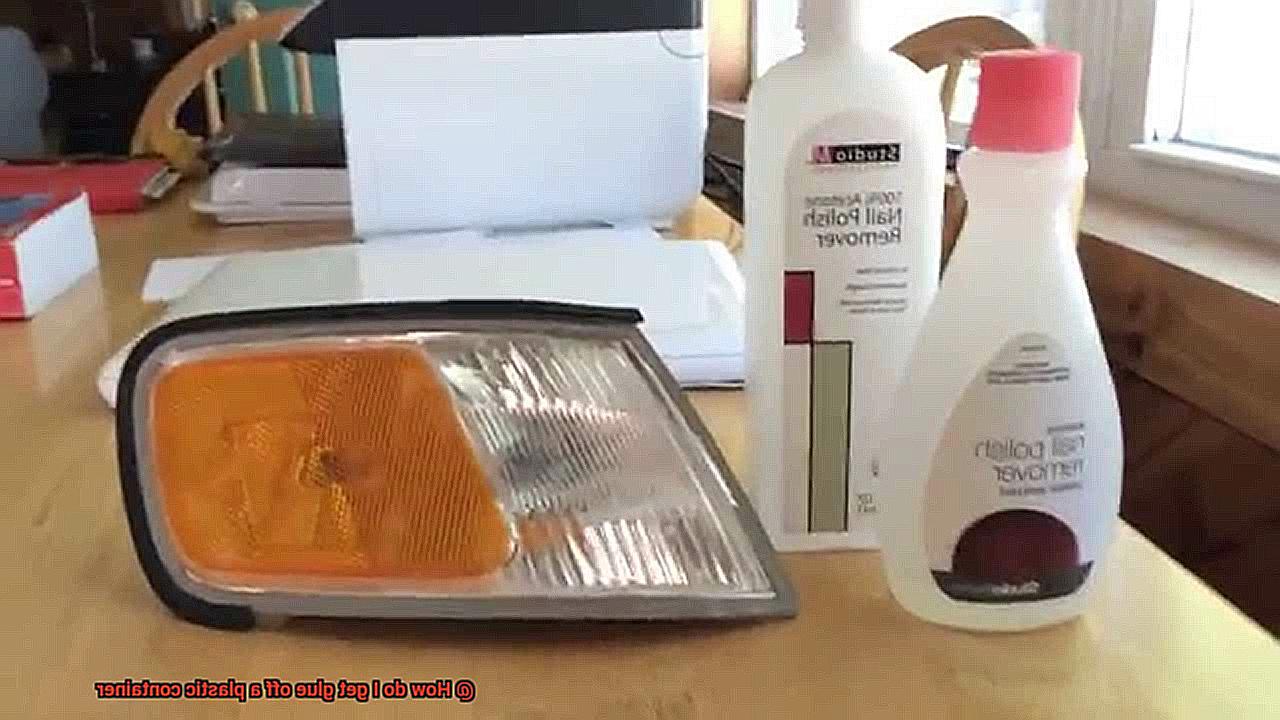
Why go the DIY route, you ask? Well, not only are these solutions cost-effective, but they also harness the power of everyday household items you probably already have at your disposal. So let’s dive into this enchanting realm of glue removal, where vinegar, rubbing alcohol, and cooking oil take center stage.
Vinegar: The Acidic Warrior
Picture this: a bottle of vinegar emerges from your pantry, ready to wage war against glue. This household hero possesses acidic powers that can effortlessly dismantle adhesive bonds. For minor cases, dilute vinegar with water to unleash its gentle yet effective touch.
Simply apply the solution directly onto the glue or use it in its pure form for tougher battles. Allow the vinegar to work its magic for a few minutes, then seize a scraper or cloth and gently scrape off the softened glue. Behold. Your plastic container is liberated from its sticky shackles.
Rubbing Alcohol: The Solvent Sorcerer
Now, prepare to meet the solvent sorcerer known as rubbing alcohol. Armed with solvents that dissolve adhesives with unrivaled finesse, rubbing alcohol is your go-to ally in the battle against glue. Dip a cotton ball or cloth into this potent elixir and gently scrub away at the affected area. Watch in awe as the glue surrenders before your very eyes. Remember to tread lightly to safeguard the integrity of the plastic and always work in a well-ventilated space.
Cooking Oil: The Gentle Rescuer
In our cast of characters, we have cooking oil – a gentle yet formidable solution for conquering glue residue on plastic containers. Choose your preferred kitchen oil – be it vegetable or olive – and let it unleash its magic. Generously apply the oil to the affected area and allow it to work its wonders for a few minutes. Then, armed with a scraper or sponge, gently scrape away the softened glue. Like a phoenix rising from the ashes, your plastic container will be reborn.
Soaking the Plastic Container in Warm Soapy Water
Well, fear not, because I’m here to reveal the secrets of soaking those pesky adhesive remnants away. Get ready to dive into the enchanting realm of warm soapy water and witness the magic unfold.
Soaking your plastic container in warm soapy water is a popular and effective method for a reason. Let’s break it down, shall we?
Firstly, warm water is like a superhero for your glue woes. It has the power to soften the glue, making it more pliable and easier to remove. Think of it as a soothing bath for your container, melting away all traces of adhesive frustration.
But wait, choosing the right container or basin is crucial. You want something large enough to hold your plastic container comfortably. Fill it up with warm water and add a few drops of dish soap or any mild detergent. Give it a good mix, creating a delightful soapy solution that will work its magic.
Now it’s time for your plastic container to take a dip. Submerge it fully in the warm soapy water and let it soak for at least 20-30 minutes. During this time, you can play the role of gentle agitator by swirling the container around in the water. This little dance helps the warm soapy water penetrate every nook and cranny of the glue residue, loosening its grip on your beloved container.
Once the designated soaking time is up, remove your container from its watery sanctuary and inspect it for any remaining glue residue. If you spot any stubborn spots, fear not. Grab a soft cloth or sponge and gently scrub away the residue while applying light pressure. It’s like giving your container a spa treatment – a little love and care go a long way.
Afterwards, rinse your container thoroughly with clean water to bid farewell to any lingering soap residue. Then, let it dry completely before using it again. You’ll be amazed at how fresh and glue-free your plastic container looks after this simple yet effective treatment.
But before you dive headfirst into the warm soapy water, a word of caution. While soaking in warm soapy water is generally safe for most types of plastic, it’s always wise to check the manufacturer’s recommendations. Additionally, if you’re dealing with super glue or epoxy resin, these stubborn adhesives may require alternative solutions or solvents.
Scrubbing with a Toothbrush
In our eternal quest to conquer the stickiest of situations, we have explored the wonders of warm soapy water. But what if the glue clings stubbornly, refusing to yield to our efforts? Fear not, for I am here to unveil the secret technique that will transform your plastic containers into pristine havens, free from the clutches of glue. Grab your trusty toothbrush and prepare to embark on a journey of scrubbing mastery.
Gathering the Materials:
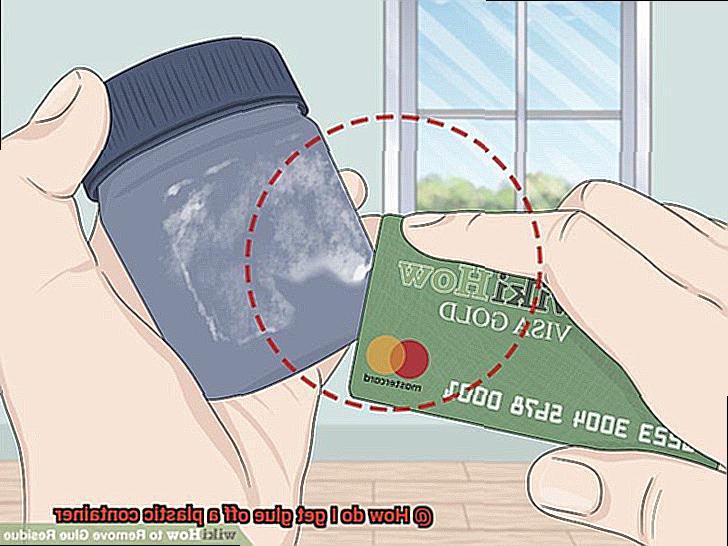
As with any grand endeavor, preparation is paramount. Equip yourself with a toothbrush adorned with soft bristles, warm water that breathes life into cleanliness, and a gentle detergent or dish soap that whispers promises of liberation. But before we plunge into this odyssey, take a moment to consult the label on your plastic container. We must ensure it possesses the fortitude to withstand the gentle touch of moisture and detergent.
The Artful Scrubbing Process:
Now that we stand on the precipice of greatness, let us delve into the essence of scrubbing finesse. Immerse your toothbrush in the warm waters of progress and anoint its bristles with a small measure of detergent or dish soap. Remember, dear comrades, our aim is for a dance of gentility and efficacy.
With your cherished toothbrush as your instrument, commence your graceful choreography upon the affected area of the plastic container. Employing minuscule circular motions, caress the surface with tenderness and poise. Bear in mind that delicate pressure is vital to shield against unsightly blemishes or harm. Should you encounter glue that defies your advances, fear not. Infuse your toothbrush with an extra measure of detergent or dish soap and press onward in unwavering determination.
Rinse and Rejuvenate:
Throughout this valiant endeavor, let the warm waters of renewal cleanse your toothbrush. Frequent rinsing shall banish any lingering residue or detritus that may accrue upon its bristles. Thus, you shall effectively eradicate the adhesive without allowing it to spread or inflict further harm.
Considerations When Removing Glue from Plastic Containers
Say goodbye to the frustration of stubborn glue residue on plastic containers. As an expert in the field, I am here to share my wealth of knowledge on the considerations you need to keep in mind when tackling this common challenge. With my guidance, you’ll be able to restore your plastic containers to their pristine glory without a trace of glue.
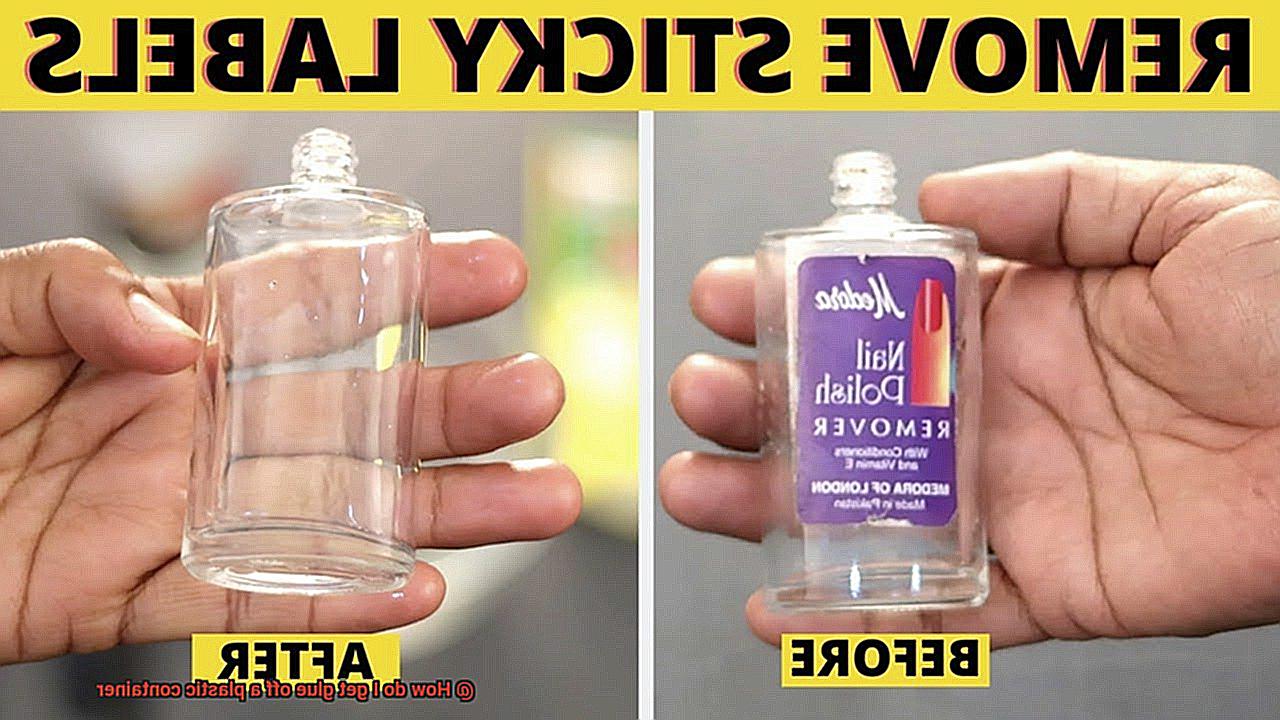
Considerations When Removing Glue from Plastic Containers:
Type of Glue – The Magical Key:
Unlock the secrets of successful glue removal by first identifying the type of glue used. Different glues demand different approaches. Water-based glues can often be conquered with a simple soak in warm water or a mild detergent, while tougher adhesives like epoxy or super glue require specialized techniques for victory.
The Plastic Conundrum:
Plastics are not created equal, and knowing the specific plastic in your container is essential before embarking on glue removal. Certain plastics may react poorly to solvents or cleaning agents, potentially causing damage or discoloration. Unravel the mystery by checking the recycling symbol, which reveals if it’s PET, HDPE, PVC, PP, or another type.
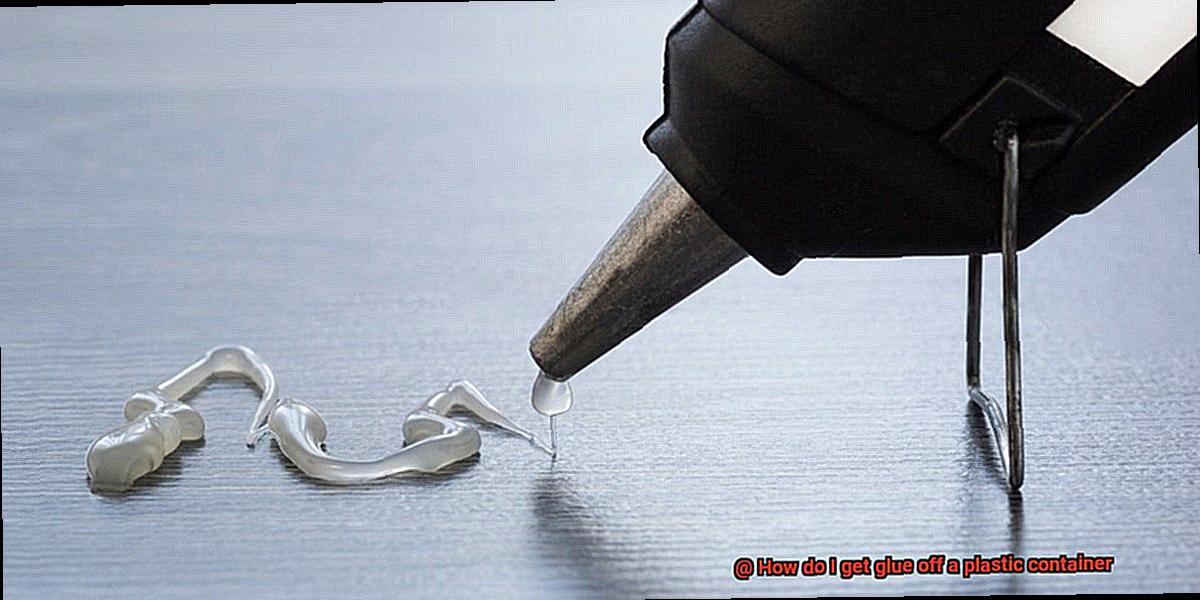
The Tiny Test That Saves the Day:
Before launching a full-scale cleaning campaign, exercise caution and test your chosen method on a small, inconspicuous area of the plastic. This preliminary experiment ensures that your approach is both safe and effective for that particular combination of glue and plastic.
Safety First:
Prioritize safety as you embark on your glue removal journey. Work in a well-ventilated area, shield your hands with gloves, protect your eyes with safety glasses, and keep cleaning agents out of reach from curious children and pets.
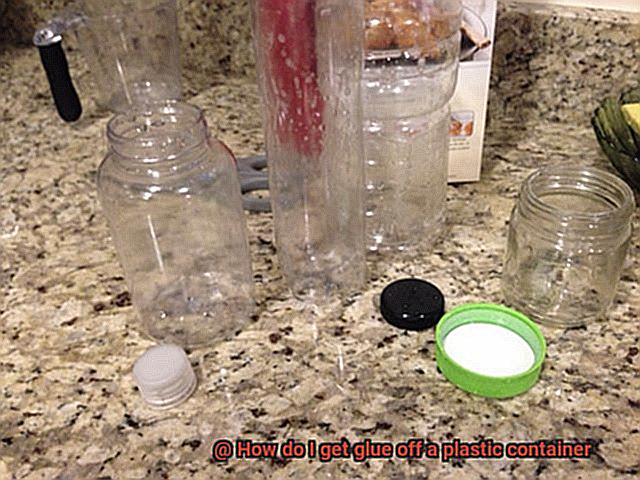
Gradual Wins the Race:
When faced with stubborn glue residue, take a gradual approach for triumphant results. Begin with milder techniques like rubbing alcohol or vinegar, gradually increasing in strength with stronger solvents or commercial adhesive removers. This strategic progression minimizes the risk of damaging the plastic surface.
Gentle Techniques for Plastic Delicacy:
Handle your plastic containers with the tender touch they deserve by employing gentle techniques that won’t harm or scratch the surface. Soft cloths, cotton swabs, or plastic scrapers become your allies as you delicately scrape or rub away the glue residue. Avoid abrasive materials that could cause unintended damage.
vAGunOLpjNs” >
Conclusion
Removing glue from a plastic container can be quite the challenge.
There are several effective methods you can try. One option is to use rubbing alcohol or nail polish remover, which can dissolve the adhesive and make it easier to remove.
Another approach is to apply heat to the glue using a hairdryer or warm water, as this can soften it and allow you to gently scrape it off with a plastic scraper or your fingernail. If all else fails, you can always turn to commercial adhesive removers specifically designed for removing stubborn glue residue from plastic surfaces.
Remember to test any solution on a small, inconspicuous area of the container first to ensure it doesn’t cause any damage.

